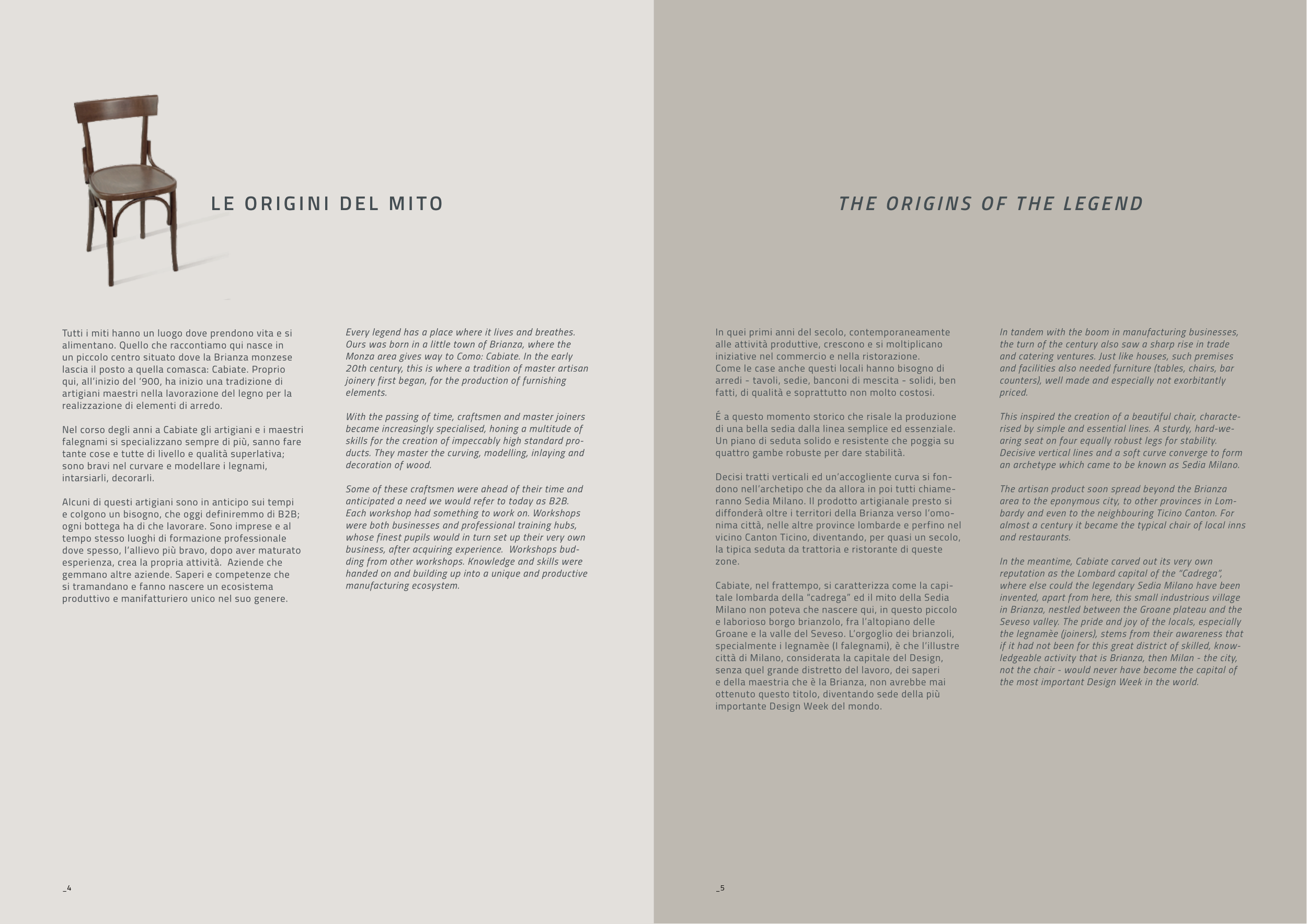LE OR I G IN I D EL M ITO
T H E O RI G I NS O F T H E L EG E ND
Tutti i miti hanno un luogo dove prendono vita e si
alimentano. Quello che raccontiamo qui nasce in
un piccolo centro situato dove la Brianza monzese
lascia il posto a quella comasca: Cabiate. Proprio
qui, all’inizio del ‘900, ha inizio una tradizione di
artigiani maestri nella lavorazione del legno per la
realizzazione di elementi di arredo.
Nel corso degli anni a Cabiate gli artigiani e i maestri
falegnami si specializzano sempre di più, sanno fare
tante cose e tutte di livello e qualità superlativa;
sono bravi nel curvare e modellare i legnami,
intarsiarli, decorarli.
Alcuni di questi artigiani sono in anticipo sui tempi
e colgono un bisogno, che oggi definiremmo di B2B;
ogni bottega ha di che lavorare. Sono imprese e al
tempo stesso luoghi di formazione professionale
dove spesso, l’allievo più bravo, dopo aver maturato
esperienza, crea la propria attività. Aziende che
gemmano altre aziende. Saperi e competenze che
si tramandano e fanno nascere un ecosistema
produttivo e manifatturiero unico nel suo genere.
Every legend has a place where it lives and breathes.
Ours was born in a little town of Brianza, where the
Monza area gives way to Como: Cabiate. In the early
20th century, this is where a tradition of master artisan
joinery first began, for the production of furnishing
elements.
With the passing of time, craftsmen and master joiners
became increasingly specialised, honing a multitude of
skills for the creation of impeccably high standard pro-
ducts. They master the curving, modelling, inlaying and
decoration of wood.
Some of these craftsmen were ahead of their time and
anticipated a need we would refer to today as B2B.
Each workshop had something to work on. Workshops
were both businesses and professional training hubs,
whose finest pupils would in turn set up their very own
business, after acquiring experience. Workshops bud-
ding from other workshops. Knowledge and skills were
handed on and building up into a unique and productive
manufacturing ecosystem.
In quei primi anni del secolo, contemporaneamente
alle attività produttive, crescono e si moltiplicano
iniziative nel commercio e nella ristorazione.
Come le case anche questi locali hanno bisogno di
arredi - tavoli, sedie, banconi di mescita - solidi, ben
fatti, di qualità e soprattutto non molto costosi.
É a questo momento storico che risale la produzione
di una bella sedia dalla linea semplice ed essenziale.
Un piano di seduta solido e resistente che poggia su
quattro gambe robuste per dare stabilità.
Decisi tratti verticali ed un’accogliente curva si fon-
dono nell’archetipo che da allora in poi tutti chiame-
ranno Sedia Milano. Il prodotto artigianale presto si
diffonderà oltre i territori della Brianza verso l’omo-
nima città, nelle altre province lombarde e perfino nel
vicino Canton Ticino, diventando, per quasi un secolo,
la tipica seduta da trattoria e ristorante di queste
zone.
Cabiate, nel frattempo, si caratterizza come la capi-
tale lombarda della “cadrega” ed il mito della Sedia
Milano non poteva che nascere qui, in questo piccolo
e laborioso borgo brianzolo, fra l’altopiano delle
Groane e la valle del Seveso. L’orgoglio dei brianzoli,
specialmente i legnamèe (I falegnami), è che l’illustre
città di Milano, considerata la capitale del Design,
senza quel grande distretto del lavoro, dei saperi
e della maestria che è la Brianza, non avrebbe mai
ottenuto questo titolo, diventando sede della più
importante Design Week del mondo.
In tandem with the boom in manufacturing businesses,
the turn of the century also saw a sharp rise in trade
and catering ventures. Just like houses, such premises
and facilities also needed furniture (tables, chairs, bar
counters), well made and especially not exorbitantly
priced.
This inspired the creation of a beautiful chair, characte-
rised by simple and essential lines. A sturdy, hard-we-
aring seat on four equally robust legs for stability.
Decisive vertical lines and a soft curve converge to form
an archetype which came to be known as Sedia Milano.
The artisan product soon spread beyond the Brianza
area to the eponymous city, to other provinces in Lom-
bardy and even to the neighbouring Ticino Canton. For
almost a century it became the typical chair of local inns
and restaurants.
In the meantime, Cabiate carved out its very own
reputation as the Lombard capital of the “Cadrega”,
where else could the legendary Sedia Milano have been
invented, apart from here, this small industrious village
in Brianza, nestled between the Groane plateau and the
Seveso valley. The pride and joy of the locals, especially
the legnamèe (joiners), stems from their awareness that
if it had not been for this great district of skilled, know-
ledgeable activity that is Brianza, then Milan - the city,
not the chair - would never have become the capital of
the most important Design Week in the world.
_4
_5


